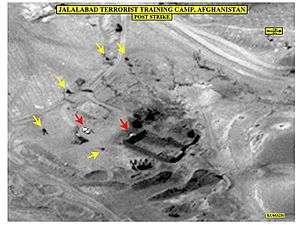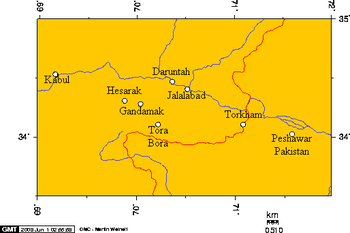Darunta training camp
The Darunta training camp (also transliterated as Derunta) was one of the most well-known of many military training camps that have been alleged to have been affiliated with al Qaeda.[1]


Training with poisons
CNN published a story in which they claimed to have acquired videotapes showing al Qaeda experiments poisoning dogs with chemical weapons, at Darunta.[2]
Location
The camp is reported to have been near Jalalabad. According to The Guardian, it was 15 miles from Jalalabad, just north of the village of Darunta across the dam.[3] According to a paper by Hekmat Karzai, published by the Pentagon the camp was really a complex of four camps, eight miles from Jalalabad.[4] Karzai wrote that the four camps were:
| Abu Khabab camp |
|
| Assadalah Abdul Rahman camp |
|
| Hizbi Islami Camp |
|
| Taliban camp |
|
The CIA provided intelligence, pinpointing Osama bin Laden's presence, that enabled Northern Alliance allies to bombard him in at the Darunta camp in 1999.[5]
The documents from some Guantanamo captives, such as Abbas Habid Rumi Al Naely, state that the Khalden training camp was also located in Darunta.[6]
Administration
Some sources claim the director of the camp was Midhat Mursi.[7]
Dispute over whether Darunta was an al Qaeda camp
During his Administrative Review Board Abdul Bin Mohammed Bin Abess Ourgy acknowledged attending the Darunta camp, but he disputed that it was affiliated with al-Qaeda.[8][9] He asserted that the Derunta camp was a non-al Qaeda camp, that dated back to the Soviet occupation of Afghanistan, that it was originally run by the Hezbi Islami, and that after his attendance there the Derunta camp was one of the many non-al Qaeda camps that the Taliban shut down at al Qaeda's request.
Other Guantanamo captives have reported that the similarly well-known Khalden training camp was not an al-Qaeda camp, and was shut down in 2000, at Osama bin Laden's request.
Alleged attendees
| Nabil Aukal[10] |
Attended in 1997 with four other members of Hamas |
| Moazzam Begg | |
| Menad Benchellali[13] | Alleged to be a "chemical weapons" specialist |
| Abdul Haddi Bin Hadiddi[14] | The detainee reportedly received military training on the use of light arms in the Darunta Camp in Jalalabad, Afghanistan. |
| Riyad Bil Mohammed Tahir Nasseri[15] | Alleged to have attended both Khalden and Darunta. |
| Ahmed Ressam[16] | The "millennium bomber"; admitted that he trained how to manufacture advanced explosives and make electronic circuits for six weeks at the camp.[17][18] |
| Hisham Sliti[19] | Alleged to have attended both the Khalden training camp and Derunta. |
| Saed Khatem Al Malki |
During his Administrative Review Board Saed Khatem Al Malki faced the allegations[20] a:
|
| Abdul Bin Mohammed Bin Abess Ourgy |
During both his Combatant Status Review Tribunal and Administrative Review Board Abdul Bin Mohammed Bin Abess Ourgy faced the allegations:[8][9]
|
| Hisham Sliti | |
| Abdul Haddi Bin Hadiddi | |
| Riyad Bil Mohammed Tahir Nasseri |
|
| Sada Jan |
|
References
-
Elizabeth Van Wie Davis (January 2008). "Uyghur Muslim Ethnic Separatism in Xinjiang, China". Asia-Pacific Center for Security Studies. Retrieved 2010-03-21.
A January 2007 Chinese raid on a training camp in Xinjiang killed 18 terrorist suspects and one policeman. Seventeen more suspects were reported captured and explosives were seized. The raid was said to have provided new evidence of ties to “international terrorist forces.” The raid marks the latest clash between Uyghur Muslim separatists and Chinese security services, reflecting a limited challenge to China’s mainland stability. In Beijing’s view, however, instability in Xinjiang could also bring instability to Tibet, Inner Mongolia, and Taiwan. As with many of these disputes throughout Asia, the root causes of the problem are a complex mix of history, ethnicity, and religion, fueled by poverty, unemployment, social disparities, and political grievances.
- Disturbing scenes of death show capability with chemical gas Archived April 7, 2013, at the Wayback Machine, CNN, August 19, 2002
- Al-Qaeda's trail of terror, The Guardian, November 18, 2001
- Hekmat Karzai. "The return of the black turban: Causes of the Taliban resurgence" (PDF). Institute Of Defence And Strategic Studies. p. 185. Retrieved 2010-03-16.
- Flawed Ally Was Hunt's Best Hope: Afghan Guerrilla, U.S. Shared Enemy, Washington Post, February 23, 2004
- Summary of Evidence memo (.pdf) prepared for Abbas Habid Rumi Al Naely's Combatant Status Review Tribunal - October 25, 2004 - page 65
- WANTED: Midhat Mursi al-Sayid 'Umar - Up to $5 Million Reward Archived 2006-01-10 at the Wayback Machine. Rewards for Justice
- Summarized transcripts (.pdf), from Abdul Bin Mohammed Bin Abess Ourgy's Combatant Status Review Tribunal - pages 34-42
- Factors for and against the continued detention (.pdf) of Abdul Bin Mohammed Bin Abess Ourgy Administrative Review Board, May 2, 2005 - page 48
- Moderately Deadly: Yassin’s long history of terror, National Review, March 26, 2004
- Jihadist or Victim: Ex-Detainee Makes a Case, The New York Times, June 15, 2006
- Guantánamo Bay files: Profiles of the 10 released British prisoners, Ian Cobain, The Guardian, April 25, 2011
- An Al Qaeda 'Chemist' and the Quest for Ricin Archived 2007-09-27 at the Wayback Machine, Middle East Info, May 5, 2004
- Summary of Evidence (.pdf) Archived 2006-07-31 at the Wayback Machine prepared for Abdul Haddi Bin Hadiddi's Combatant Status Review Tribunals - October 13, 2004 - page 53
- Summary of Evidence memo (.pdf) Archived 2006-07-31 at the Wayback Machine prepared for Riyad Bil Mohammed Tahir Nasseri's Combatant Status Review Tribunal - October 21, 2004 page 148
- Al-Qaeda - a meaningless label, The Guardian, January 12, 2003
- U.S. Court of Appeals for the Ninth Circuit (February 2, 2010). "U.S. v. Ressam" (PDF). Archived from the original (PDF) on March 1, 2012. Retrieved February 27, 2010.
- "Ressam Testimony in Mokhtar Haouari Trial". Southern District of New York. July 2001. Retrieved February 27, 2010.
- Summary of Evidence (.pdf) Archived 2006-07-31 at the Wayback Machine prepared for Hisham Sliti's Combatant Status Review Tribunals - November 19, 2004 - page 62
- Summarized transcript (.pdf) Archived 2006-07-31 at the Wayback Machine, from Saed Khatem Al Malki's Administrative Review Board hearing - page 180
- Factors for and against the continued detention (.pdf) of Riyad Bil Mohammed Tahir Nasseri Administrative Review Board, April 27, 2005 - page 5
- Abuse testimony (.pdf), from Sada Jan's Combatant Status Review Tribunal - page 2